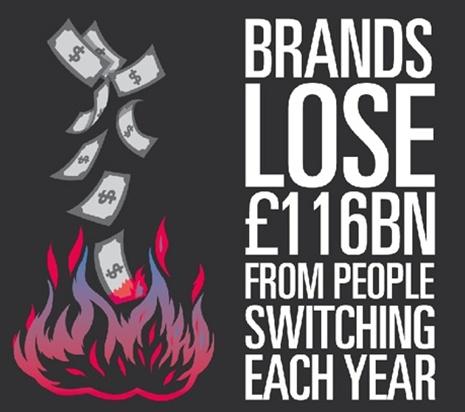£116 billion - the true cost of bad service

Poor service costs UK brands £116 billion every year. That’s the headline figure from new research from Accenture, which found that over half (53%) of British consumers had switched provider in at least one industry in the last twelve months. To put this in context, the equivalent of 12 per cent of UK consumers’ annual disposable income is being switched due to bad service.
According to the Accenture Global Consumer Pulse study 23% of customers have switched from one retailer to another due to poor service, followed by 14% changing banks and 13% moving utilities. At the other end of the scale, airlines had the lowest figures for switching (3%). Overall, customer loyalty is extremely low. On a scale of 1-10 just 16% rate their loyalty to brands as between 8 and 10, with over a third (36%) scoring between 1 and 3.
The research found that the reason for this high level of switching is a fundamental disconnect between digital and traditional modes of customer support. Just 4% of UK consumers thought companies successfully combined all channels when it came to customer service. 81% still use the phone to get in touch, even though just 45% were happy with the results. The picture painted by the Accenture research demonstrates three key trends that we’ve seen in the market:
1 Customers are increasingly demanding
Whatever the industry, consumers expect a superior customer experience, through their channel of choice. The balance of power has moved from brand to consumer, and more and more people are happy to switch if they receive poor or inadequate service. Additionally, as they are easier to access, digital channels are driving people to get in contact more often, increasing the volume of interactions that brands need to satisfy.
2 Channel choice is growing, not shrinking
The Accenture research highlights that poor performance on online channels is preventing businesses from migrating their customers from phone and face-to-face contact to become digital by default. While this is partly true, many consumers still want to call a brand or discuss products in person, meaning that companies need to deliver a consistent service across every channel. These need to be joined up, so that consumers can move from one to another during the customer journey, without needing to repeat themselves or re-enter information.
3 Knowledge is power
Three out of the top four customer service priorities for consumers relate to human qualities of the staff they are talking to. However, while over half are happy with agent politeness, only 45% thought staff were knowledgeable and just 35% felt they could help solve problems without having to refer to other people. This demonstrates a need for better access to centralised information that will empower frontline staff so that they can improve satisfaction levels. Collecting and sharing knowledge across every channel would also solve another pain point the study highlighted – the inability to access information in a convenient way online or on mobile devices.
As the economy continues to grow, consumers are becoming increasingly confident and happy to switch if brands don’t provide what they are looking for. The Accenture findings show the scale of the cost to companies – now is the time to review customer service across every channel and ensure it meets consumer needs before they move elsewhere.








Comments